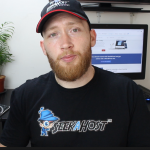It’s been a while since remote working has moved from a backup plan to a new normal. And the tendencies today don’t seem to change any time soon, even when the pandemic is almost over. New working strategies have brought new challenges, including cyberattacks and security threats.
Many businesses enjoy the possibility to hire remote developers for the new projects. Remote work allows finding the best tech talents around the world, reducing costs on offices, and adding diversity to the current team.
However, with all the external threats, it’s important to understand how a secure remote worker can protect their work and your company’s functioning.
Let’s look at all the security challenges that working from home brings with it.
Top 5 Popular Security Threats Among Remote Specialists

The threat landscape is always dynamic, with new menaces regularly appearing here and there. An innocent email at first glance can turn into a total disaster for the entire business.
Previously, IT specialists could easily monitor the whole infrastructure, setting up extra security measures. Today, when the specialists are spread across the world, companies need to take an extra step to protect all their assets.
The number of threats that affect secure remote working is much bigger, but we’ve chosen the most repetitive ones across global tech businesses.
1. Unsecured Wi-Fi Network
Working remotely supposes specialists to work from home. They can equally work from the homes of their relatives, working areas, or even public spaces, such as airports, restaurants, and trains. Finishing coding on the go or connecting to an important meeting from a business trip involves connecting to public Wi-Fi. With weak protection, such individuals become the first victims of digital attackers.
Once connected to a public network, a secure remote worker becomes vulnerable to such threats as stealing confidential and sensitive information or unauthorized access from a third party. Serious breaches lead to disruption of business operations and data loss.
2. Phishing Mails
Phishing is a never-ending issue, even for secure remote workers. Such type of mail continues progressing, resembling real senders, and misleading even the most experienced users.
Phishing emails usually imitate familiar communication, gaining the trust of workers and making them click on the inserted links. Such an attack can steal an individual’s and company’s financial information and inject malware infections that erase data. This can damage a company’s reputation and lead to legal consequences.
3. Data Privacy Issues
Data privacy is always accompanied by risks of fraud, unauthorized access, and stolen sensitive information. It can be compromised due to malware or transfer of confidential information to third parties.
To remain secure, remote workers should take extra steps with authentication and password storage. This issue brings one of the biggest harms to a company’s reputation and financial losses.
4. Risky Video Conferences
If not encrypted or protected with passwords, an ordinary video conference with a team can be interrupted by unauthorized users. Not only can the attackers hear sensitive information, but also take control and send malware through sharing files and links.
Another risk is the invitation to the meeting. As in the case of phishing, the link can contain malware that steals credentials or personal information.
5. Unsteady Backup
The backup is the basis for secure remote working. Remote specialists should have the same level of protection as if they were working from the office. If there is no defined backup, the company remains more vulnerable to cyberattacks and incomplete recovery of data afterwards.
Updating and maintaining backup systems on a regular basis guarantees that companies can quickly restore data in the event of a variety of threats, protecting their operations and brand.
How to Secure Remote Workers?

There are no protection measures that would put the remote specialists on the completely safe side.
However, there are some common practices that can minimize the risks of intervention and reduce the vulnerability of the working space.
1. Use VPN
If your developers work remotely or connect from public spaces, ask them to always use the VPN. It works as an intermediary between a developer and a company’s network, protecting your secure remote worker and their data.
2. Regularly Update Software
Whether your specialists use your corporate network, operating systems, or applications for development, ensure they are always up-to-date. New updates usually contain improved security patches that better detect malicious data. Improved security tools reduce the overall vulnerability of the company.
3. Use Multi-Factor Authentication
The more encrypted the data, the fewer the chances of stolen credentials and access to sensitive information. The multifactor authentication adds an extra layer of security. If the first combination of user and password can be compromised, the second factor is less likely to be known to the attackers.
4. Monitor Access Controls
Ensure that every file, space, or call in your company is locked. It requires time to provide access to the newcomers, but it will secure your data on a regular basis. Be vigilant while allowing others to join your calls or open your folders. Otherwise, your data may fall into the wrong hands.
5. Train Your Workers
This step is one of the most important. Once you establish all the security measures, you should train your workers and remind them of the rules during the whole year. A secure remote worker is not only the one who uses tools, but the one who takes critical decisions and makes correct choices.
Protected and Trusted: Final Thoughts

Security has become one of the hot topics among companies and prioritizing it above other themes is a must. The most important is to have a proactive approach, installing new software programs that help to cope with attacks, and reminding employees to follow a set of rules. Data privacy breaches, security threats, malware, and loss of sensitive data are the main contributors to a company’s crisis.
And even if technically the problem can be quickly solved, the finance and the customer’s respect behind can be lost forever. If you don’t have a separate security department, ensure you devote at least a couple of specialists, depending on your company’s size, who’ll monitor, update, and prevent all the security challenges that may arise. It is imperative that your company maintain a state of alertness, modify security protocols in response to the dynamic threat environment, and consistently provide remote specialists with cybersecurity best practices training.
Author Profile

- Content writer and WordPress website developer. I also love to create content on YouTube and other social platforms as well as promotional and social marketing.
Latest entries
 Business AdviceAugust 29, 2024How can managed IT Services make your Business more efficient?
Business AdviceAugust 29, 2024How can managed IT Services make your Business more efficient? BusinessJune 5, 20248 Expert Hacks to Optimise Your Website for Maximum Lead Generation
BusinessJune 5, 20248 Expert Hacks to Optimise Your Website for Maximum Lead Generation Must Read NewsMarch 14, 2024Top 7 Trending Software Development Technologies in 2024
Must Read NewsMarch 14, 2024Top 7 Trending Software Development Technologies in 2024 Must Read NewsFebruary 28, 2024Top 8 Cybersecurity Tools For Mobile Devices
Must Read NewsFebruary 28, 2024Top 8 Cybersecurity Tools For Mobile Devices


